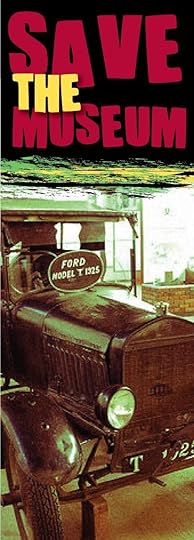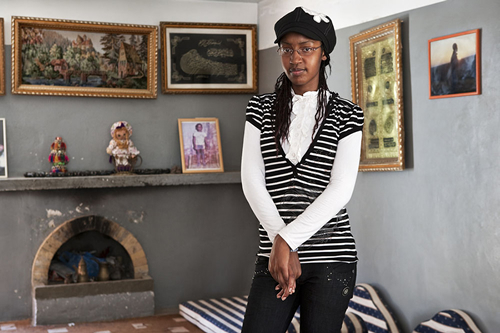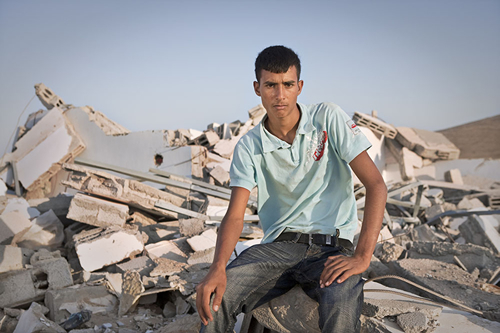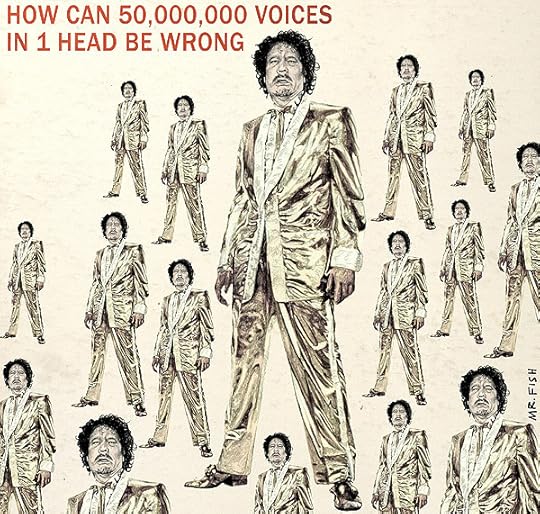Sean Jacobs's Blog, page 671
March 10, 2011
Revolution is not good for tourism
Is this what we can expect from Tina Brown? What drove Newsweek's editors to commission and publish a feature–in the latest issue–on "Five Places to See Before the Revolution." In breathless prose, reporters Dan Ephron and Claire Martin list five countries–Morocco, Jordan, Gabon, Ecuador and Nepal–that modern seize-the-day Hemingways should get to soon, before agitation for the Rights of Man disrupt their travel plans. Popular uprisings are basically treated as nuisances in the piece, not only because they reveal the oppressive structures behind the tourist-poster versions of favoured nations, but because they cause trip-cancellations.
That's a picture of Gabon's Loango National Park above. The link to the entry for the park (which is breathtaking of course; we're not disputing that) treats us to a flock of birds, in mid-flight. The giddy caption–after noting the repression in post-independence Gabon–assures us: "Thankfully, the poaching hasn't spoiled Loango's safari parks, which are flush with chimpanzees, elephants, and lowland gorillas."
Oh, and Gabon apparently has a reputation as "Africa's last Eden." I thought that was a contest between Naimbia and Zambia. And to say nothing of the fact that it was if any of these places were prelapsarian Edens then why would the Adams and Eves therein need revolutions?
The famed Galapagos Islands are also given the nod. But the last time I checked, there's no real threat of a "revolution" in Ecuador; in any case the troubles there are really a case of anti-democratic elements in the police challenging the authority of the elected, very popular, government.
In addition to the "jungle" Edens, we also get the "ancient-but-destroyed-civilisation" Edens. Here's the description for Morocco, equal parts Orientalism and just plain silliness:
When you think of exotic Marrakech, you probably think of Doris Day and Jimmy Stewart blazing a path in Hitchcock's The Man Who Knew Too Much—not anti-government protests like the ones that rocked the "Red City" (and 50 others in Morocco) during February. Marrakech is one of the nation's former imperial cities and still boasts the region's largest bazaar. Protests also spread to the ancient city of Fez, in the northeast. The city is often considered the soul of Morocco, and its oldest district, Fes el Bali, built in the ninth century, is a maze of unpaved alleys lined with fountains, hundreds of mosques, and museums (also, increasingly, dissidents).
In between the mixed messages in this entry and others, one thing is clear: "the nation has been run—and robbed—by one family" (insert dictator's name). Nothing of course about our own governments' complicity in making that robbery possible. And soon enough, the revolting masses will want them "to go the way of the Mubaraks and Ben Alis," disrupting all adventures. Apparently, dictators are good for game park/ancient monument tourism.
Ah, dissidents. The flies on a visitor's repast, once well-controlled by a proper autocrat.
The link to the rest of the entries.–Sean Jacobs, Neelika Jayawardane








Street Photographers in Brazzaville
By Lebon Ziavoula, a member of Congo-Brazzaville photographers collective, Generation Elili.
Via Afrique in Visu.








Angola: '32 years is too much'
On Monday this week 17 people, including several journalists (some from the newspaper Jornal Novo), were arrested at the start of a demonstration, heavily monitored by police, in the Angolan capital, Luanda. As former BBC Angolan correspondent Lara Pawson, writes in The Guardian, "… the protest began as an internet campaign two weeks ago when an anonymous group of individuals, announcing 'a new revolution of the Angolan people,' set up a website calling for an end to the 32-year rule of President José Eduardo dos Santos."
A ruling party official is quoted as saying "Angola is not Egypt. Angola is not Libya. Angola is not Tunisia." To preempt the protests, the ruling MPLA organized countrywide "pro-peace" rallies last Saturday. They claimed half a million people turned up. More objective counts suggest averages of twenty thousand. And as Pawson concludes about the pro-government rallies: "… this was not an authentic outpouring of adoration for the regime. State employees were ordered to attend, and beyond the capital all did not go well." The government also does not rule out violent repression against protesters.
Though Monday's protest failed to draw large numbers of people (or got little attention in Western media), Pawson notes a "generation gap" between those organizing protests and the regime's supporters among the "political class." One of those arrested Monday was Luaty Beirão, an Angolan rapper also known as Ikonoklasta:
[Ikonoklasta] believes the political parties are out of touch with the majority of Angolan people, and are either too lazy or too old-fashioned to take action for their political beliefs. At a gig on 27 February in Luanda, he called for President Dos Santos to leave power [and he called for the Monday, March 7 protests]. Each time he did, a large audience of mainly young men chanted "Fora!" ("Out!"). To the delight of his fans, he described the regime as "a son of a bitch government" and ended his performance holding up a banner which read: "Ti Zé Tira o Pé: Tô Prazo Expirou Há Bwé!" (Uncle Zé [the president], get out: your time ran out ages ago!). The crowd erupted into wild applause.
Below is the video footage of Ikonoklasta's brave intervention followed by a translation, via Mhambi's blog, of his remarks:
Angola
Government motherfucker
I´m a kamikaze
why this has to be like that?
Why speaking about them has to be life threat?
Mr Danilo, if you are here, run and tell daddy (Dos Santos),
tell him please, that we don´t want him anymore here
32 years is to much… a lot!
Until when that shit!? Of intimidatory policy
you say, I´m going to shut up you at home
see right, your brother, your uncle, your father, think right
attention, i do know where you live,
why??
the other gave the opinion of him saying Zé Du must die
is censoring the sound, it´s the opinion of a frustrated
he is frustrated with the situation
Mr Dino Matross, Mr Virgílio De Fontes Pereira, every you, suck!!
Paulo Flores said that "oppressor of the oppressed" get out!! no??
The first Dino Matross is threatening the population
"oppressor of the oppressed" get out!!
Mr Dino Matross, Mr Virgílio De Fontes Pereira Out!!!!
Attention, I want to see on 7th
who is the pure REVU, on 7th
everybody already know
if we live till there, let´s see if I show everything so you can read
calm down, put clear Edu, put it clear:
YOU ZÉ TRHOW THE FEET, YOUR TIME IS OVER…. IN BWÉ
Independence square 7 this our day, Libya is achieving, Kadafi is going to fall
Zé Dú isn´t going to be anymore a friend, we don´t want more, we don´t want more
Bring only pans and spoons, we don´t want aggression
don´t bring party flags…please
to make noise with vuvuzelas and kitchen things
nobody wants party
Thank you very much
Join to the fight for total independence of Angola from the Dictator Jose Eduardo Dos
Santos and all his comitive !
Translation by comrade Paulo of Galicia
H/T: Nerina Penzhorn.








The first-encounter aesthetic rush
If you're wondering what took us so long to say something about South African rapper Spoek Mathambo's new music video — for his cover of Joy Division's "She's in Control", well, we can't make up our mind about it.
The video, above, got a lot of attention when it first came out in late February as it was directed by Spoek's countrymen, celebrated photographer Pieter Hugo and Michael Cleary (cinematographer of 'Not everything was cool back then'). Hipster blogs and mainstream Western media love the video, though we don't learn much from them beyond repeating the PR copy.
First up the positives: We're fans of Spoek Mathambo, whether it's his music or his far-out blog. As for what he did to the original tune: Spoek infused a nice South African flavor into it, which makes us appreciate both songs more. The choice of cover also makes sense. Spoek has spoken about his admiration for Joy Division's music elsewhere:
… I am into Joy Division more than rap … I went from being super into rap my whole life, to a point where I was specifically anti-rap, and then into obscure and avant-garde jazz. When I was probably twenty-one, I got 10GB of music which opened me up to this world of white music that had been hidden from me my whole life.
So people expect him to go to New York, and give his nod to hip hop. But for those of us who remember Joy Division's gimmick-free challenge to the landscape of 1970s Brit punk, it's easy to see why Spoek would feel an affinity with good music from the other point in the Atlantic triangle.
Still, like most things, the video also left us with more questions than anything else.
The selling point of the video is that it depicts the world of "township cults and teen gangs." That sounds interesting, but we don't see much of that in the video. Instead we get kids — apparently members of a Langa, Cape Town-dance troupe ("Happy Feet")– and Spoek. And lots of chalk-blowing. Also, we wondered whether the trance-like dancing featured in the video is really that big in Langa (or any other Cape Town neighborhood).
More generally, we're trying to figure out why it is that the videos that generally become popular outside of (especially) South Africa and that enters popular "hipster" circles or sites based in North America and Europe, tend to be those that tick one or all the boxes of what appeals to us about our Dark Other: if it's not poverty and the crying and dying show, Africa is voodoo, (black) magic, primitivity, and all that is inscribed within the realm of the "unknowable." (Though not as layered, see also Die Antwoord's latest attempt at attention, "Rich Bitch".)
We detect Hugo's hand in the direction of the aesthetics in "In Control": the South African photographer, remember him for his Nollywood images, co-directed the video. His characteristic interest in creating visual links between the surreal, blackness, and the occult are rehashed here, in moving images. Here, the boys and girls of Happy Feet become cut-throat child-soldiers/zombies in an other-worldly, bombed out apocalyptic landscape, dabbling in the occult and snuff-games. The black-and-white island of order-disorder is remarkably absent of adults, and death looms as large as the Christianity offered by Spoek–the sole adult here, luminescent in white, marked with the cross. In one frame, the boys shave an initiate's head: the wall behind is inscribed with the message: "OUT OF ORDER."
We get it: Nollywood-surreal is a big reference and inspiration in these videos. But we question whether Nollywood retains a sustained interest amongst hipsters beyond the first-encounter aesthetic rush. While we too responded as gutturally and instinctively as any viewer — after all, we also live in the same soup of Africa-images, and find the visual noise just as arresting as we are meant to–we wonder about Spoek's choice to pander to the base expectations. Especially when his whole oeuvre seems to point towards finding a new conversation, not type.








March 8, 2011
Music Break
'Shaka Zulu'
Not sure what to make of the video. The video was filmed "in Africa." Kage Sparks, who calls himself "the African Street Ambassador," and whose family hails from Kenya and Tanzania, has his "tribe riding for me."








Save the Museum (in Uganda)
Just about this time last year, Uganda lost a priceless part of its cultural heritage when the Kasubi Tombs were burnt down. The tombs were a UNESCO World Heritage Site and were built in 1882 – the burial place of four Buganda kings.
Now it seems another cultural site faces destruction. Global Voices reports on a campaign in Uganda to save the Uganda Museum, founded in 1908.
Apparently the ministry of Tourism, Trade and Industry plans to build a 60-storey office building on the site (I wonder whether there were many fights between the Tourism and the Trade and Industry factions over that one).
Not only does the museum house some important exhibits, but according to the Facebook page set up by the Save the Museum Campaign, it's the oldest museum in Eastern Africa.–Brett Davidson








'18 year-old Arabs living in Israel'
Photographer Natan Dvir's images of "18 year-old Arabs living in Israel" were inspired by his realization that he knew little, and understood less about Israel's Arab society. Arabs consist of "over a fifth of the population," but these "hundreds of thousands of families who continue to live within Israel's borders" are invisible within Jewish society. Dvir "became interested in the stories of these people living as a minority in a country defined by its majority's religion." The images are of men and women – all of them 18 years old. He'd hoped that as teenagers approaching adulthood, they may be "especially aware of an identity crisis and willing to talk about it."
Among the 18 year olds is Reeham (picture above), a Bedouin girl from a family of 11 brothers and sisters. Her family came to Israel from Sudan, and now "live in neighborhoods 7, 11 & 20 in Rahat, the only Bedouin city in Israel."
Here, her family still tries to "preserve elements of our nomad culture": movies, theatres, and nightclubs are not a part of the neighbourhood; "Men hang out in hookah bars or playing snooker, while women spend their time at home or visiting friends." She plans to become a doctor – an ambition that her family encourages. Her brothers tell her to go and study in England or Jordan, though she imagines medical school in Russia. It's a new beginning for her here: a future full of possibilities.
"It is extremely rare that a Bedouin woman would be allowed to study away from home not escorted by a male family member, so I am very grateful for my family's support."
Others don't have as easy an entry to their hopes. Sliman, another Bedouin from Shkip (one of the 47 Bedouin villages not recognized by the state of Israel) explains that the authorities do not provide them with water or electricity nor allow them to build permanent houses.
His home was destroyed a week after they received the court order: "Many policemen arrived at the village, evicted us out of the house and destroyed it together with 6 other buildings." In the image, Sliman sits on the rubble that is left after his home was demolished.
"My father served 23 years in the Israeli army. Two of my older brothers were about to join the army, yet refused to do so after our house was demolished. I do not want to serve a country that doesn't respect the Bedouins and denies us of our rights. All I dream about is having a big house with running water and electricity as others do."
* Dvir's work is available on Lens Culture, an online magazine featuring international contemporary photography, art, media, and world cultures.–Neelika Jayawardane.








March 7, 2011
Head Case
'50,000,000 voices in one head'
Sean Jacobs's Blog
- Sean Jacobs's profile
- 4 followers


























